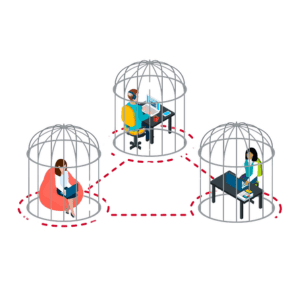70% of company mistakes are due to poor communication.
Gartner Research
Effective employee communication in the workplace is an integral part to the success of any organization. It is what drives productivity, relationships and engagement and also mitigates conflict. During the pandemic, we saw the adoption of remote working from companies all over the world. Because of this, businesses need to be on top of their communication now more than ever.

In this blog, we will talk about how employee communication affects the workplace and the benefits it brings when done right.
What is Employee Communication?
Employee communication refers to the methods and processes used by an organization to share information, engage, and connect with its workforce. It encompasses a wide range of activities, from formal announcements and corporate newsletters to informal chats and social media interactions. Effective employee communication is pivotal for fostering a positive work environment, aligning the workforce with company goals, promoting transparency, and encouraging collaboration. It acts as the backbone for organizational culture, ensuring that it informs, hears, and motivates employees, thereby contributing to overall business success.
The increasing importance of communication in the workplace
In the current global workplace, workforces are becoming increasingly more mobile, or remote. With that, the ways in which colleagues and managers communicate are changing. With these changes, managers are finally understanding the importance of communicating effectively in the workplace, and are actively developing strategies around it.
Over the last decade, roles in communication have continued to grow, and according to the U.S Bureau of Labor Statistics, it won’t be slowing down any time soon. In fact, employment in communication occupations is projected to grow 14 percent from 2020 to 2030, faster than the average for all occupations.
The Impact of Poor Employee Communication on the Workplace
The best way to highlight the importance of employee communication in the workplace is to break down the common issues that arise from poor skills/strategies.
COMMUNICATION SILOS
Employees often receive unnecessary content due to poor communication standards. When this amount of content becomes too much, it creates information silos. Essentially, this means that employees are overwhelmed with information, and important communications get lost amongst the noise.
AVOIDABLE ERRORS
Accuracy and efficiency are two of the main reasons to highlight the importance of communication in the workplace. As you can imagine, without the right tools or processes, important messages, instructions, or policies can be miscommunicated. Poor communication of information could easily have been avoided, ultimately resulting in mistakes or errors. These errors often have costs associated with them, leading to an impact on your bottom line.
LOSS OF KNOWLEDGE
Communication is the foundation for the transfer of knowledge between employees. Without this transfer of knowledge, organizations are literally leaking money. One study has shown the value of effective knowledge transfer for manufacturing companies. Those that had the right communication strategies in place for knowledge transfer saw huge savings.
Operating costs were reduced by $2 billion annually, energy savings amounted to $1 billion, and exploration/production costs were reduced by $50-$250 billion. These figures represent the money leaking out of organizations that fail to recognize the importance of communication in the workplace around knowledge transfer.
Poor communication also hinders the development of teamwork and affects the relationship between employees, managers and departments. Miscommunication can create tensions, conflicts, and lack of trust among employees. The lack of clear expectations, goals, and feedback leads to decreased morale and motivation.
This results in a toxic work environment and affects overall job satisfaction, leading to higher absenteeism and staff burnout. Poor communication also undermines the ability of managers to lead effectively, as they struggle to get their message across, delegate tasks, and receive accurate and timely updates. So, now that you have an understanding of the impact poor employee communication can have… Let’s look at how effective employee communication can truly be.
The impact of Effective Employee Communication
Productivity & Profitability
Productivity is arguably the most important aspect of any organization and is one of the main components to whether a business is successful or not. Communication greatly effects productivity. Effective communication mitigates the chance for misunderstandings to occur and allows for all employees to be on the right track when it comes to working on tasks.
Managers often waste time poorly communicating their tasks to subordinates. This leaves employees confused about the exact goal at hand. Employees can also feel more empowered through effective communication. The more information your employees have the more confident and direct they will be in their output.
According to the case study of HEC. prof. Charles-Henri. Besseyre des Horts, it is proven that those companies that are transparent and employees have more empowerment, are usually more productive.
It is also important to have the right software in place to allow for clear communication. Celayix mitigates the possibility of poor communication through our mobile app which allows employees and managers to seamlessly communicate to each other through the Celayix portal.
Shift-based employees across various industries can easily understand their location of work, hours, and payroll. Employees should contact their line managers if they encounter an error or misinterpretation. The Celayix chat feature allows them to keep all workplace communications in one secure location.
Client Relationships
Communication is essential throughout the employee onboarding process. For new employees, being trained in a new role requires a high standard of communication. This makes sure that they are as well equipped for their tasks going forward.
The better trained your employees are in a client-facing role, the happier your clients will be with the service they are receiving. Efficiently trained customer support associates can:
- Mitigate and resolve conflict
- Understand clients’ needs
- Help the customer feel understood
- Present new information in a way in which the client will be more receptive
Increases Employee engagement
Employee engagement involves providing the right conditions for all members of an organization to give of their best each day and commit to their organization’s goals and values.
1. Leadership communication
Research shows that leadership communication is the most influential internal communication factor to employee engagement. Internal communication teams have a powerful role in supporting, coaching and reminding leaders of communication’s importance. Line managers especially need robust communication training; many become managers because of their communication skills, rather than because they’re good at their jobs.
CEOs, directors and their leadership teams must be the organization’s best communicators. Internal communicators should be part of senior leadership teams, not only to keep communication at the top of the agenda, but also to coach and support leaders in their communication. This is especially important, as face-to-face communication about the organization’s vision, strategy and progress is strongly linked to better employee engagement.
2. The organization’s reputation
Anything that affects what employees think of the organization they work for or what they think their friends and family think of the organization they work for directly correlates with employee engagement. We spend 40% of our lives at work. So, of course, we want our organization to reflect our goals and identity.
Businesses should communicate topics that elevate their reputation in employees’ minds. Orientate this around positive media coverage, awards and prizes, and corporate social responsibility. You should also provide the organization’s stance on negative media coverage.
3. Employee voice
Employee voice is a very important element of employee communication. It greatly correlates with employee engagement and often isn’t utilized effectively. Employee voice is when employees believe they have a say, and that it leads to action. It’s when employees feel heard!
Many leaders talk about two-way communication, but rarely practice it which can be a waste when it comes to maximizing your workforce through communication.
They can support and influence leaders to encourage and enable employees to have a voice, both in their day-to-day roles and with bigger business issues. In many cases employees are actually more aware of issues in relation to their managers and so make sense to empower them. Communicators can also provide a platform where employees can share their opinions.
Use an informal channel, such as enterprise social media, or a more formal platform, such as an employee feedback tool. Listen to employees, and share their ideas with the people in influential positions.
Mitigates Conflict
Naturally, employee communication has a big role to play in conflict management. Poor communication leads to misunderstandings and eventual conflict. It is essential for organizations to implement clear channels of communication to avoid such damaging issues. With the workplace becoming a more diverse environment, misinterpretations are becoming more likely.
Each individual must be clear in what they intend to convey to others. Thoughts must be carefully put into sensible and relevant words for others to understand well. The use of derogatory words towards subordinates is especially discouraged. It often escalates conflict quickly and affect more than one individual.
Effective communication is also done by assuming others may not have carried out a particular task before. So, you need to teach them certain things. Haphazard thoughts only add on to confusion and result in displeasure and disagreements. It is important to communicate sufficient and correct information to your employees.
This makes them appropriately prepared when they attempt a task. Don’t just communicate for the sake of it. The inclusion of workers is an essential aspect of management. People generally observe that conflict among individuals arises when they feel neglected or left out.
Transparency is essential at all levels for better understanding and avoiding conflicts.
ORGANIZATIONAL ALIGNMENT
One of the main functions of internal communications in the workplace is to educate employees on your core values, purpose, mission and vision. Without effective workplace communication skills, this will never be fully achieved. In fact, only 23% of executives say that their companies are excellent at aligning employees’ goals with corporate purposes.
The benefits of organizational alignment are priceless. Employees are driven, loyal, and engaged, productivity soars, workplace culture grows and the company expands. This further illustrates the importance of communication in the workplace.
How to Improve Communication in the Workplace
We recently broke down essential communication skills to have as a leader in the workplace, so be sure to take a look at those first! Once you have those communication skills down, it’s time to turn those skills into workplace strategies. Now that you understand the importance of open communication in the workplace, here are some key actions you can take to work to improve it.
REGULAR CHECK INS
Taking the time to check in with employees is vital. This opens up opportunities for clarification on instructions, and to remind employees about individual and company goals. Simply dedicating the time to opportunities to improve communication is a great place to start. Even though it might take time to find a cadence and process that works for you and your employees, it will improve over time.
COMPANY CULTURE
Internal communications should always be a key element of your company culture. Enforce open, positive communication the same way you encourage other key elements of the company culture such as employee wellness, adaptability etc. A great way to do this is simply to remind employees about the importance of communication in the workplace.
You can also take other initiatives such as workshops, focus groups and town halls, where openness and honesty are highlighted. The end goal is to ensure that all team members are comfortable communicating with everyone in the company, particularly managers.
TECHNOLOGY
Finding the right employee communication tools to suit your workforce needs is also key to improving your workplace communication. This will be unique to your business needs, including the needs of your employees. Aside from the typical communication apps, like Slack, Zoom or Teams, what other tools do you have in place? Specifically, what are you using to communicate company goals, vision and mission?
Some workplaces lean towards intranets for these needs. However, according to Medium, 31% of workers have never used their organization’s intranet at all! Instead, employers should be finding technology that appeals to all employees, with features such as relevant groups, personalized news feeds, and instant messaging/notifications. These features engage employees, and involve them in internal communications in a fun way! Celayix, for example, has a great communications platform which gives employees a dedicated channel to discuss scheduling issues, outside of their own personal apps!
These actions paired with the right communication skills can set you on the right path to improving your employee communication strategy. Consequently, you will reap the rewards of an engaged workforce, with improved productivity & profitability.
Don’t underestimate Employee Communication
Never underestimate the importance of effective employee communication in the workplace. It is what drives productivity, workplace relationships, engagement, and conflict mitigation. Without these components, organizations would not be able to function effectively. Both managers and employees need to be mindful of the way and manner in which they communicate with other workers.
The implementation of clear and strong communication channels is essential to the growth and success to the company. Workers feel more empowered, comfortable and welcome in their daily work lives which in turn drives productivity.










